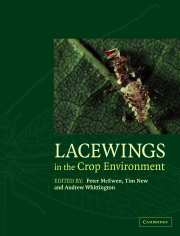Book contents
- Frontmatter
- Contents
- List of contributors
- Preface
- PART 1 Lacewing systematics and ecology
- PART 2 Lacewings in crops
- PART 3 Principles
- PART 4 Case studies
- Introduction to Part 4
- CHAPTER 18 Micromus tasmaniae: a key predator on aphids on field crops on Australasia?
- CHAPTER 19 Preliminary notes on Mallada signatus (Chrysopidae) as a predator in field crops in Australia
- CHAPTER 20 An evaluation of lacewing releases in North America
- CHAPTER 21 Chrysoperla externa and Ceraeochrysa spp.: potential for biological control in the New World tropics and subtropics
- CHAPTER 22 Comparative plant substrate specificity of Iberian Hemerobiidae, Coniopterygidae, and Chrysopidae
- CHAPTER 23 Lacewings in Sardinian olive groves
- CHAPTER 24 Lacewing occurrence in the agricultural landscape of Pianura Padana
- CHAPTER 25 Lacewings and snake-flies in Piedmont vineyards (northwestern Italy)
- CHAPTER 26 Control of aphids by Chrysoperla carnea on strawberry in Italy
- CHAPTER 27 Artificial overwintering chambers for Chrysoperla carnea and their application in pest control
- CHAPTER 28 Lacewings in Andalusian olive orchards
- CHAPTER 29 The green lacewings of Romania, their ecological patterns and occurrence in some agricultural crops
- CHAPTER 30 Biological control with Chrysoperla lucasina against Aphis fabae on artichoke in Brittany (France)
- PART 5 Conclusion
- Taxonomic index
- General index
CHAPTER 21 - Chrysoperla externa and Ceraeochrysa spp.: potential for biological control in the New World tropics and subtropics
Published online by Cambridge University Press: 04 May 2010
- Frontmatter
- Contents
- List of contributors
- Preface
- PART 1 Lacewing systematics and ecology
- PART 2 Lacewings in crops
- PART 3 Principles
- PART 4 Case studies
- Introduction to Part 4
- CHAPTER 18 Micromus tasmaniae: a key predator on aphids on field crops on Australasia?
- CHAPTER 19 Preliminary notes on Mallada signatus (Chrysopidae) as a predator in field crops in Australia
- CHAPTER 20 An evaluation of lacewing releases in North America
- CHAPTER 21 Chrysoperla externa and Ceraeochrysa spp.: potential for biological control in the New World tropics and subtropics
- CHAPTER 22 Comparative plant substrate specificity of Iberian Hemerobiidae, Coniopterygidae, and Chrysopidae
- CHAPTER 23 Lacewings in Sardinian olive groves
- CHAPTER 24 Lacewing occurrence in the agricultural landscape of Pianura Padana
- CHAPTER 25 Lacewings and snake-flies in Piedmont vineyards (northwestern Italy)
- CHAPTER 26 Control of aphids by Chrysoperla carnea on strawberry in Italy
- CHAPTER 27 Artificial overwintering chambers for Chrysoperla carnea and their application in pest control
- CHAPTER 28 Lacewings in Andalusian olive orchards
- CHAPTER 29 The green lacewings of Romania, their ecological patterns and occurrence in some agricultural crops
- CHAPTER 30 Biological control with Chrysoperla lucasina against Aphis fabae on artichoke in Brittany (France)
- PART 5 Conclusion
- Taxonomic index
- General index
Summary
The Neotropical chrysopid fauna is one of the richest in the world; 21 genera and more than 300 species have been described (Brooks & Barnard, 1990) and numerous taxa await description. Despite this diversity, very little is known about the life histories of most species and the systematics of the group is poorly resolved (Penny, 1984; Adams & Penny, 1985, 1986; Tauber & Adams, 1990). Nevertheless, during the last decade interest in the chrysopids has increased, especially with regard to their use in biological control.
CERAEOCHRYSA AND CHRYSOPERLA: GENERA OF PRIMARY IMPORTANCE TO BIOLOGICAL CONTROL
Of the eight chrysopine genera that occur in the Neotropics, we propose that Chrysoperla and Ceraeochrysa have the greatest potential for use in biological control. We base this conclusion on a number of life history and behavioural traits that these two taxa express. Species in both genera occur in a variety of habitats (e.g. dry and moist forests, grasslands, horticultural settings) and are commonly associated with agricultural crops (Muma, 1959a; Adams, 1982; Olazo, 1987; Brooks & Barnard, 1990). Their larval prey includes a large number of economically important insect pests (see below). Moreover, both genera are well adapted for mass-rearing and use in augmentative biological control(Núñez, 1988a, b;Nordlund & Morrison, 1992; Albuquerque et al., 1994; Wang & Nordlund, 1994; López-Arroyo et al., 1999a, c, 2000).
Chrysoperla externa (Hagen) shares many features with the Holarctic Chrysoperla carnea (Stephens) s. lat., which is produced commercially and marketed for release throughout North America, Europe, and parts of Asia, and it is an excellent candidate for mass-production and use in biological control programs in Latin America (Albuquerque et al., 1994).
- Type
- Chapter
- Information
- Lacewings in the Crop Environment , pp. 408 - 423Publisher: Cambridge University PressPrint publication year: 2001
- 22
- Cited by



